BUS267 - Change Management Essay: Myths, Realities, and Practices
VerifiedAdded on 2022/11/25
|6
|1367
|216
Essay
AI Summary
This essay examines the critical aspects of change management within organizations, addressing the drivers for change stemming from both external factors like competition and economic shifts, and internal factors such as technological advancements and restructuring. It debunks common myths, such as the ease and speed of implementation, and highlights the significant issues, including employee resistance, communication breakdowns, and workplace conflicts. The essay further explores the realities of change management practices, emphasizing the need for effective communication, employee involvement, and conflict resolution strategies. It also delves into methods for overcoming resistance through education, training, and negotiation, while acknowledging the potential risks of coercive approaches. The analysis concludes with a reflection on the importance of change management for maintaining competitive advantage and achieving long-term organizational success, emphasizing the need for a strategic and adaptable approach.
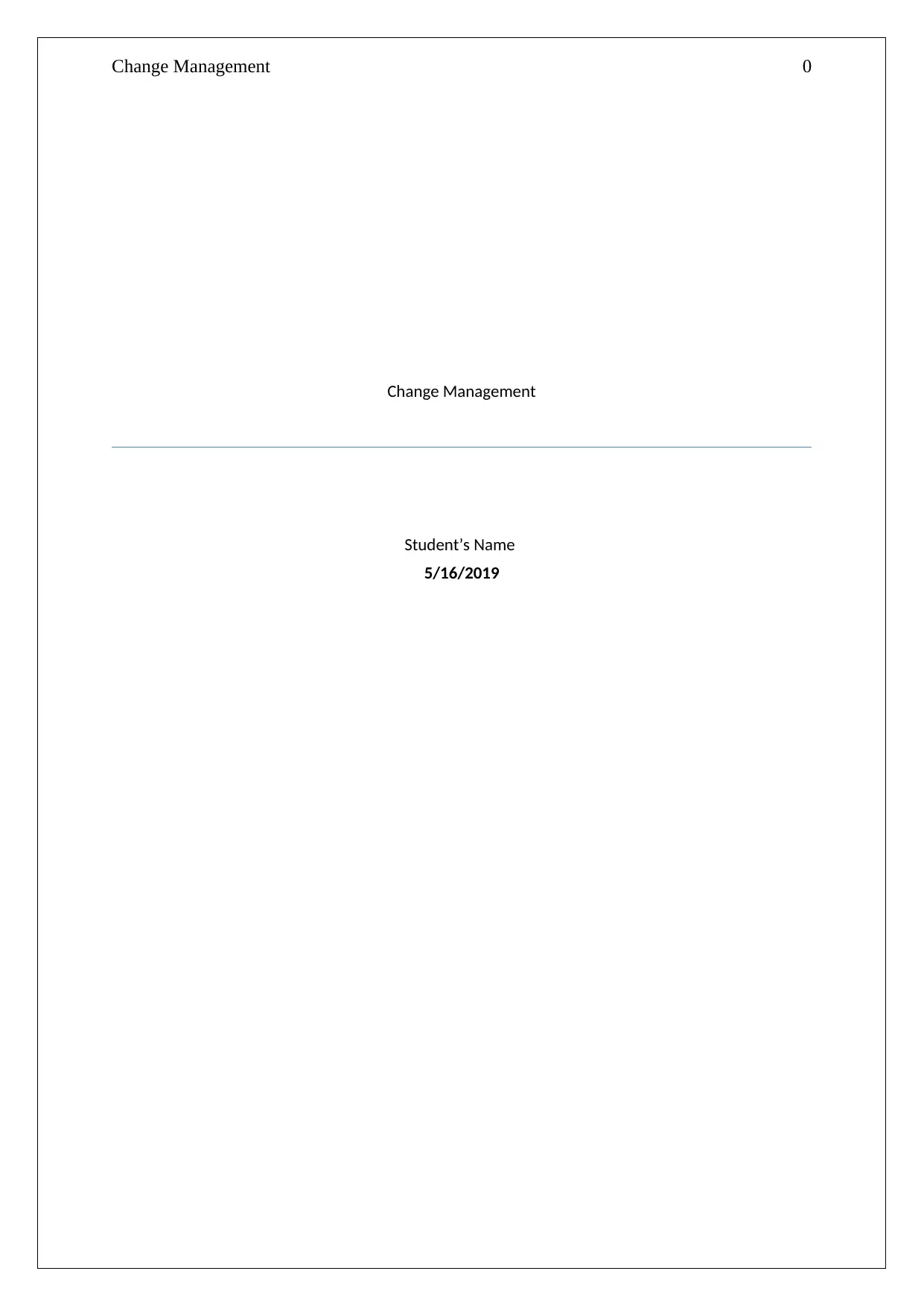
Change Management 0
Change Management
Student’s Name
5/16/2019
Change Management
Student’s Name
5/16/2019
Paraphrase This Document
Need a fresh take? Get an instant paraphrase of this document with our AI Paraphraser
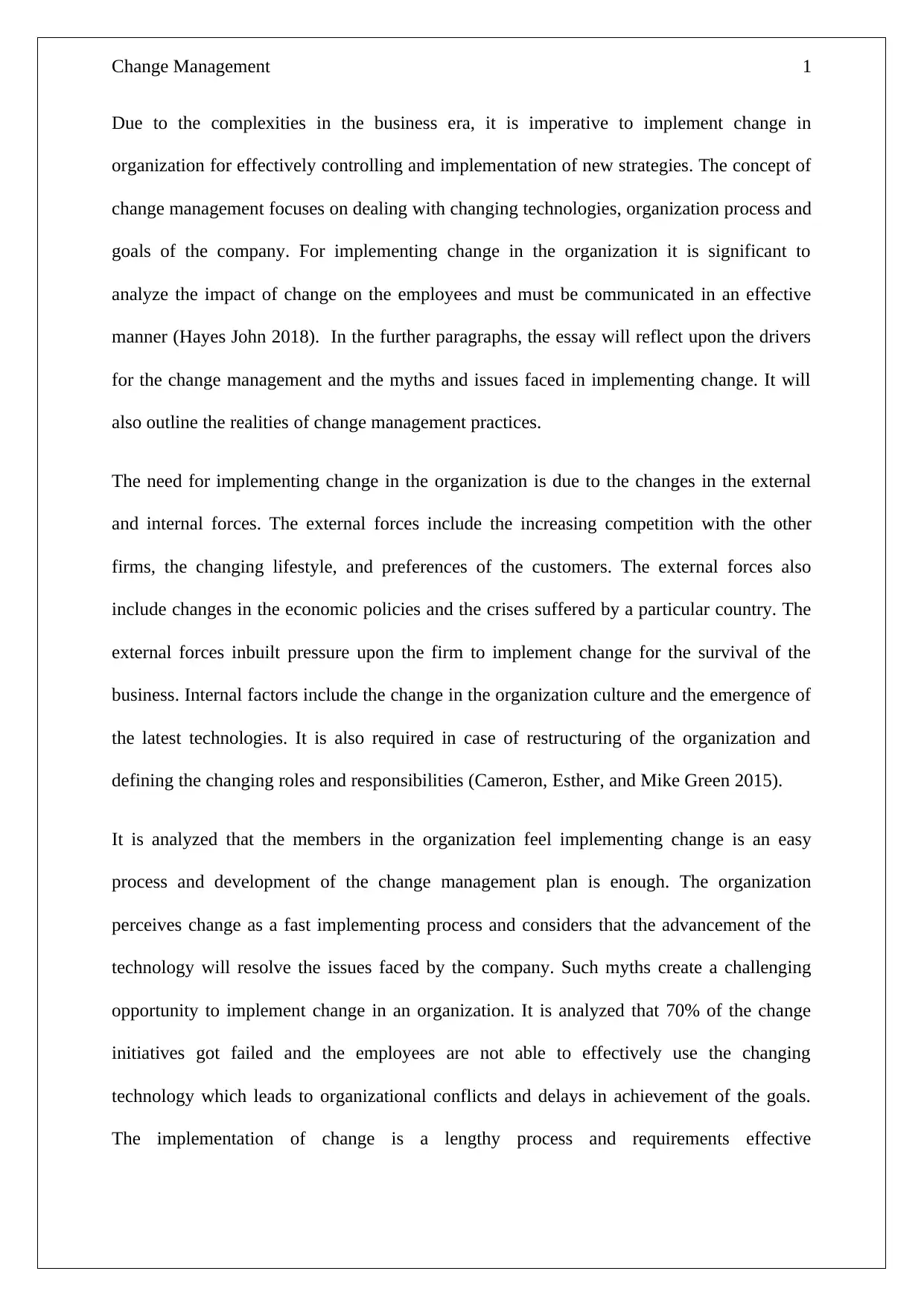
Change Management 1
Due to the complexities in the business era, it is imperative to implement change in
organization for effectively controlling and implementation of new strategies. The concept of
change management focuses on dealing with changing technologies, organization process and
goals of the company. For implementing change in the organization it is significant to
analyze the impact of change on the employees and must be communicated in an effective
manner (Hayes John 2018). In the further paragraphs, the essay will reflect upon the drivers
for the change management and the myths and issues faced in implementing change. It will
also outline the realities of change management practices.
The need for implementing change in the organization is due to the changes in the external
and internal forces. The external forces include the increasing competition with the other
firms, the changing lifestyle, and preferences of the customers. The external forces also
include changes in the economic policies and the crises suffered by a particular country. The
external forces inbuilt pressure upon the firm to implement change for the survival of the
business. Internal factors include the change in the organization culture and the emergence of
the latest technologies. It is also required in case of restructuring of the organization and
defining the changing roles and responsibilities (Cameron, Esther, and Mike Green 2015).
It is analyzed that the members in the organization feel implementing change is an easy
process and development of the change management plan is enough. The organization
perceives change as a fast implementing process and considers that the advancement of the
technology will resolve the issues faced by the company. Such myths create a challenging
opportunity to implement change in an organization. It is analyzed that 70% of the change
initiatives got failed and the employees are not able to effectively use the changing
technology which leads to organizational conflicts and delays in achievement of the goals.
The implementation of change is a lengthy process and requirements effective
Due to the complexities in the business era, it is imperative to implement change in
organization for effectively controlling and implementation of new strategies. The concept of
change management focuses on dealing with changing technologies, organization process and
goals of the company. For implementing change in the organization it is significant to
analyze the impact of change on the employees and must be communicated in an effective
manner (Hayes John 2018). In the further paragraphs, the essay will reflect upon the drivers
for the change management and the myths and issues faced in implementing change. It will
also outline the realities of change management practices.
The need for implementing change in the organization is due to the changes in the external
and internal forces. The external forces include the increasing competition with the other
firms, the changing lifestyle, and preferences of the customers. The external forces also
include changes in the economic policies and the crises suffered by a particular country. The
external forces inbuilt pressure upon the firm to implement change for the survival of the
business. Internal factors include the change in the organization culture and the emergence of
the latest technologies. It is also required in case of restructuring of the organization and
defining the changing roles and responsibilities (Cameron, Esther, and Mike Green 2015).
It is analyzed that the members in the organization feel implementing change is an easy
process and development of the change management plan is enough. The organization
perceives change as a fast implementing process and considers that the advancement of the
technology will resolve the issues faced by the company. Such myths create a challenging
opportunity to implement change in an organization. It is analyzed that 70% of the change
initiatives got failed and the employees are not able to effectively use the changing
technology which leads to organizational conflicts and delays in achievement of the goals.
The implementation of change is a lengthy process and requirements effective
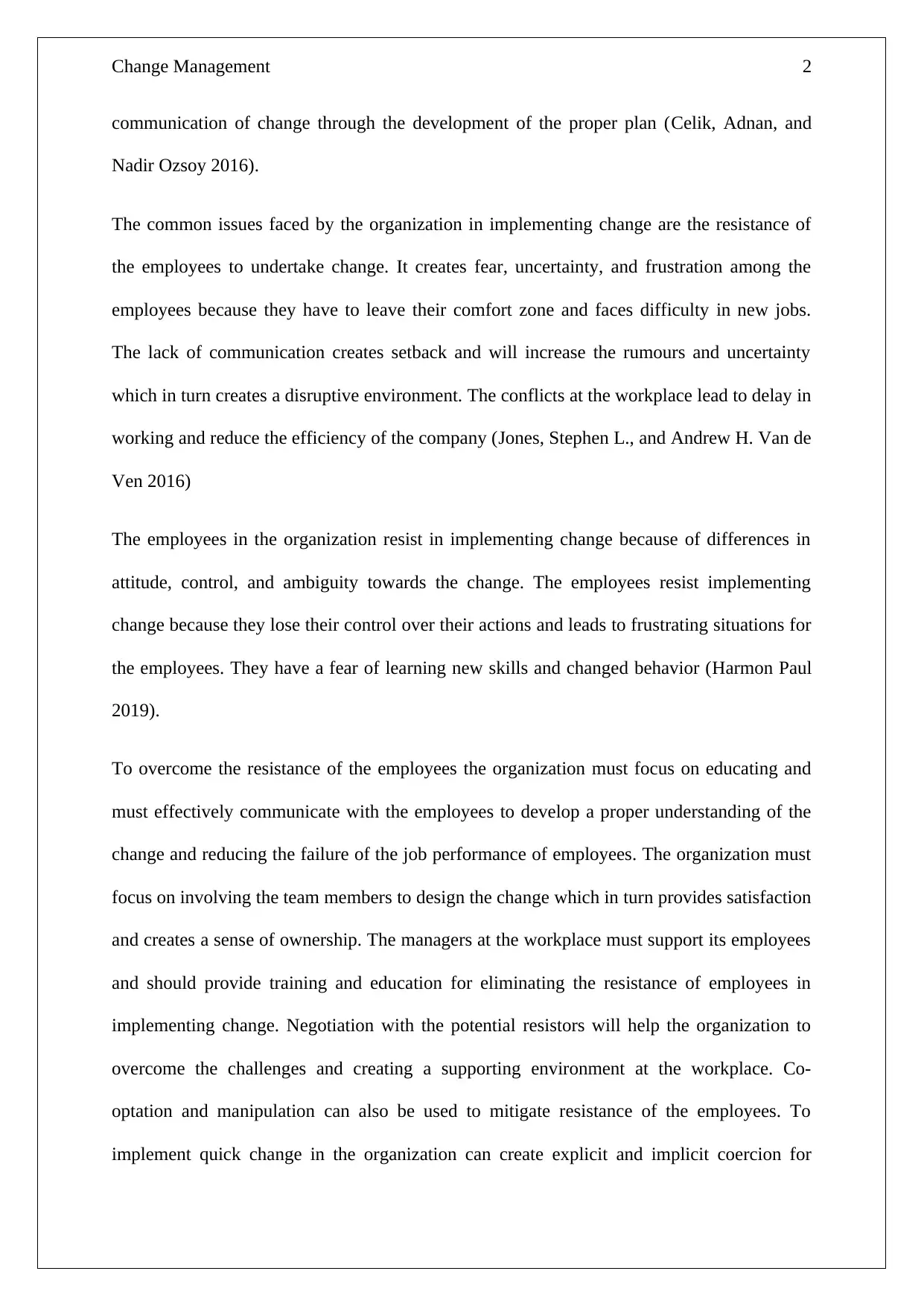
Change Management 2
communication of change through the development of the proper plan (Celik, Adnan, and
Nadir Ozsoy 2016).
The common issues faced by the organization in implementing change are the resistance of
the employees to undertake change. It creates fear, uncertainty, and frustration among the
employees because they have to leave their comfort zone and faces difficulty in new jobs.
The lack of communication creates setback and will increase the rumours and uncertainty
which in turn creates a disruptive environment. The conflicts at the workplace lead to delay in
working and reduce the efficiency of the company (Jones, Stephen L., and Andrew H. Van de
Ven 2016)
The employees in the organization resist in implementing change because of differences in
attitude, control, and ambiguity towards the change. The employees resist implementing
change because they lose their control over their actions and leads to frustrating situations for
the employees. They have a fear of learning new skills and changed behavior (Harmon Paul
2019).
To overcome the resistance of the employees the organization must focus on educating and
must effectively communicate with the employees to develop a proper understanding of the
change and reducing the failure of the job performance of employees. The organization must
focus on involving the team members to design the change which in turn provides satisfaction
and creates a sense of ownership. The managers at the workplace must support its employees
and should provide training and education for eliminating the resistance of employees in
implementing change. Negotiation with the potential resistors will help the organization to
overcome the challenges and creating a supporting environment at the workplace. Co-
optation and manipulation can also be used to mitigate resistance of the employees. To
implement quick change in the organization can create explicit and implicit coercion for
communication of change through the development of the proper plan (Celik, Adnan, and
Nadir Ozsoy 2016).
The common issues faced by the organization in implementing change are the resistance of
the employees to undertake change. It creates fear, uncertainty, and frustration among the
employees because they have to leave their comfort zone and faces difficulty in new jobs.
The lack of communication creates setback and will increase the rumours and uncertainty
which in turn creates a disruptive environment. The conflicts at the workplace lead to delay in
working and reduce the efficiency of the company (Jones, Stephen L., and Andrew H. Van de
Ven 2016)
The employees in the organization resist in implementing change because of differences in
attitude, control, and ambiguity towards the change. The employees resist implementing
change because they lose their control over their actions and leads to frustrating situations for
the employees. They have a fear of learning new skills and changed behavior (Harmon Paul
2019).
To overcome the resistance of the employees the organization must focus on educating and
must effectively communicate with the employees to develop a proper understanding of the
change and reducing the failure of the job performance of employees. The organization must
focus on involving the team members to design the change which in turn provides satisfaction
and creates a sense of ownership. The managers at the workplace must support its employees
and should provide training and education for eliminating the resistance of employees in
implementing change. Negotiation with the potential resistors will help the organization to
overcome the challenges and creating a supporting environment at the workplace. Co-
optation and manipulation can also be used to mitigate resistance of the employees. To
implement quick change in the organization can create explicit and implicit coercion for
⊘ This is a preview!⊘
Do you want full access?
Subscribe today to unlock all pages.

Trusted by 1+ million students worldwide
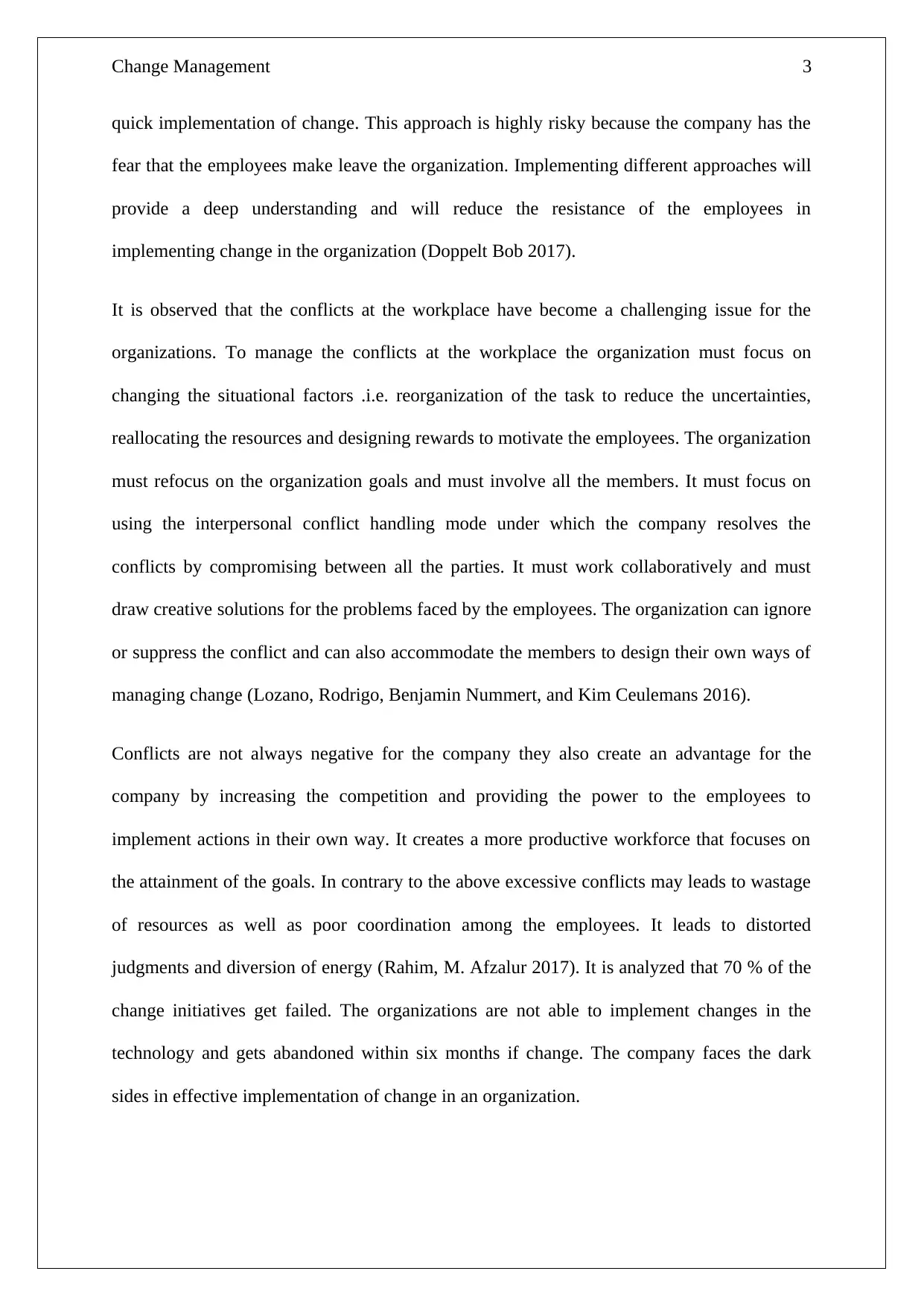
Change Management 3
quick implementation of change. This approach is highly risky because the company has the
fear that the employees make leave the organization. Implementing different approaches will
provide a deep understanding and will reduce the resistance of the employees in
implementing change in the organization (Doppelt Bob 2017).
It is observed that the conflicts at the workplace have become a challenging issue for the
organizations. To manage the conflicts at the workplace the organization must focus on
changing the situational factors .i.e. reorganization of the task to reduce the uncertainties,
reallocating the resources and designing rewards to motivate the employees. The organization
must refocus on the organization goals and must involve all the members. It must focus on
using the interpersonal conflict handling mode under which the company resolves the
conflicts by compromising between all the parties. It must work collaboratively and must
draw creative solutions for the problems faced by the employees. The organization can ignore
or suppress the conflict and can also accommodate the members to design their own ways of
managing change (Lozano, Rodrigo, Benjamin Nummert, and Kim Ceulemans 2016).
Conflicts are not always negative for the company they also create an advantage for the
company by increasing the competition and providing the power to the employees to
implement actions in their own way. It creates a more productive workforce that focuses on
the attainment of the goals. In contrary to the above excessive conflicts may leads to wastage
of resources as well as poor coordination among the employees. It leads to distorted
judgments and diversion of energy (Rahim, M. Afzalur 2017). It is analyzed that 70 % of the
change initiatives get failed. The organizations are not able to implement changes in the
technology and gets abandoned within six months if change. The company faces the dark
sides in effective implementation of change in an organization.
quick implementation of change. This approach is highly risky because the company has the
fear that the employees make leave the organization. Implementing different approaches will
provide a deep understanding and will reduce the resistance of the employees in
implementing change in the organization (Doppelt Bob 2017).
It is observed that the conflicts at the workplace have become a challenging issue for the
organizations. To manage the conflicts at the workplace the organization must focus on
changing the situational factors .i.e. reorganization of the task to reduce the uncertainties,
reallocating the resources and designing rewards to motivate the employees. The organization
must refocus on the organization goals and must involve all the members. It must focus on
using the interpersonal conflict handling mode under which the company resolves the
conflicts by compromising between all the parties. It must work collaboratively and must
draw creative solutions for the problems faced by the employees. The organization can ignore
or suppress the conflict and can also accommodate the members to design their own ways of
managing change (Lozano, Rodrigo, Benjamin Nummert, and Kim Ceulemans 2016).
Conflicts are not always negative for the company they also create an advantage for the
company by increasing the competition and providing the power to the employees to
implement actions in their own way. It creates a more productive workforce that focuses on
the attainment of the goals. In contrary to the above excessive conflicts may leads to wastage
of resources as well as poor coordination among the employees. It leads to distorted
judgments and diversion of energy (Rahim, M. Afzalur 2017). It is analyzed that 70 % of the
change initiatives get failed. The organizations are not able to implement changes in the
technology and gets abandoned within six months if change. The company faces the dark
sides in effective implementation of change in an organization.
Paraphrase This Document
Need a fresh take? Get an instant paraphrase of this document with our AI Paraphraser
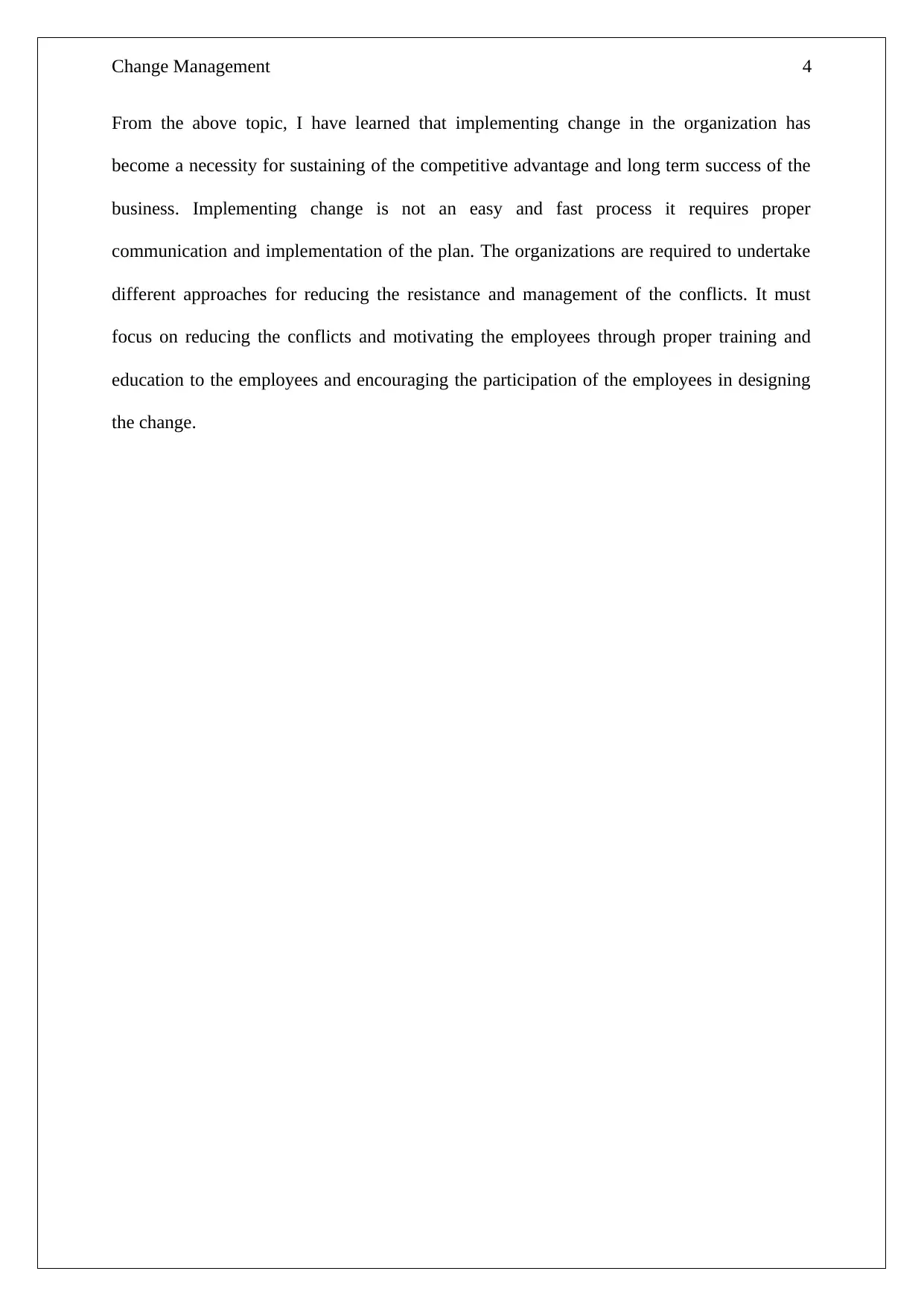
Change Management 4
From the above topic, I have learned that implementing change in the organization has
become a necessity for sustaining of the competitive advantage and long term success of the
business. Implementing change is not an easy and fast process it requires proper
communication and implementation of the plan. The organizations are required to undertake
different approaches for reducing the resistance and management of the conflicts. It must
focus on reducing the conflicts and motivating the employees through proper training and
education to the employees and encouraging the participation of the employees in designing
the change.
From the above topic, I have learned that implementing change in the organization has
become a necessity for sustaining of the competitive advantage and long term success of the
business. Implementing change is not an easy and fast process it requires proper
communication and implementation of the plan. The organizations are required to undertake
different approaches for reducing the resistance and management of the conflicts. It must
focus on reducing the conflicts and motivating the employees through proper training and
education to the employees and encouraging the participation of the employees in designing
the change.
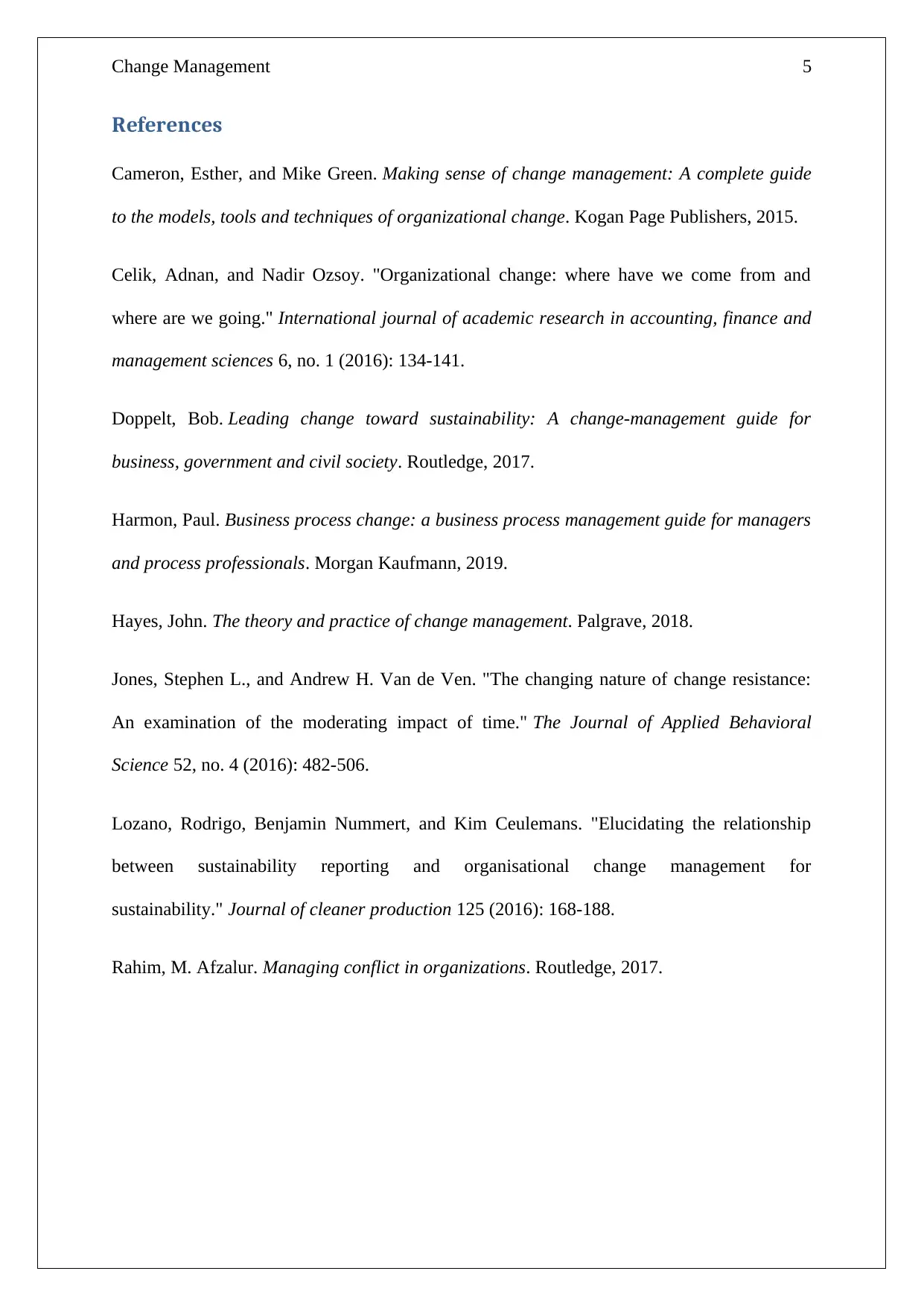
Change Management 5
References
Cameron, Esther, and Mike Green. Making sense of change management: A complete guide
to the models, tools and techniques of organizational change. Kogan Page Publishers, 2015.
Celik, Adnan, and Nadir Ozsoy. "Organizational change: where have we come from and
where are we going." International journal of academic research in accounting, finance and
management sciences 6, no. 1 (2016): 134-141.
Doppelt, Bob. Leading change toward sustainability: A change-management guide for
business, government and civil society. Routledge, 2017.
Harmon, Paul. Business process change: a business process management guide for managers
and process professionals. Morgan Kaufmann, 2019.
Hayes, John. The theory and practice of change management. Palgrave, 2018.
Jones, Stephen L., and Andrew H. Van de Ven. "The changing nature of change resistance:
An examination of the moderating impact of time." The Journal of Applied Behavioral
Science 52, no. 4 (2016): 482-506.
Lozano, Rodrigo, Benjamin Nummert, and Kim Ceulemans. "Elucidating the relationship
between sustainability reporting and organisational change management for
sustainability." Journal of cleaner production 125 (2016): 168-188.
Rahim, M. Afzalur. Managing conflict in organizations. Routledge, 2017.
References
Cameron, Esther, and Mike Green. Making sense of change management: A complete guide
to the models, tools and techniques of organizational change. Kogan Page Publishers, 2015.
Celik, Adnan, and Nadir Ozsoy. "Organizational change: where have we come from and
where are we going." International journal of academic research in accounting, finance and
management sciences 6, no. 1 (2016): 134-141.
Doppelt, Bob. Leading change toward sustainability: A change-management guide for
business, government and civil society. Routledge, 2017.
Harmon, Paul. Business process change: a business process management guide for managers
and process professionals. Morgan Kaufmann, 2019.
Hayes, John. The theory and practice of change management. Palgrave, 2018.
Jones, Stephen L., and Andrew H. Van de Ven. "The changing nature of change resistance:
An examination of the moderating impact of time." The Journal of Applied Behavioral
Science 52, no. 4 (2016): 482-506.
Lozano, Rodrigo, Benjamin Nummert, and Kim Ceulemans. "Elucidating the relationship
between sustainability reporting and organisational change management for
sustainability." Journal of cleaner production 125 (2016): 168-188.
Rahim, M. Afzalur. Managing conflict in organizations. Routledge, 2017.
⊘ This is a preview!⊘
Do you want full access?
Subscribe today to unlock all pages.

Trusted by 1+ million students worldwide
1 out of 6
Related Documents
Your All-in-One AI-Powered Toolkit for Academic Success.
+13062052269
info@desklib.com
Available 24*7 on WhatsApp / Email
![[object Object]](/_next/static/media/star-bottom.7253800d.svg)
Unlock your academic potential
Copyright © 2020–2025 A2Z Services. All Rights Reserved. Developed and managed by ZUCOL.





